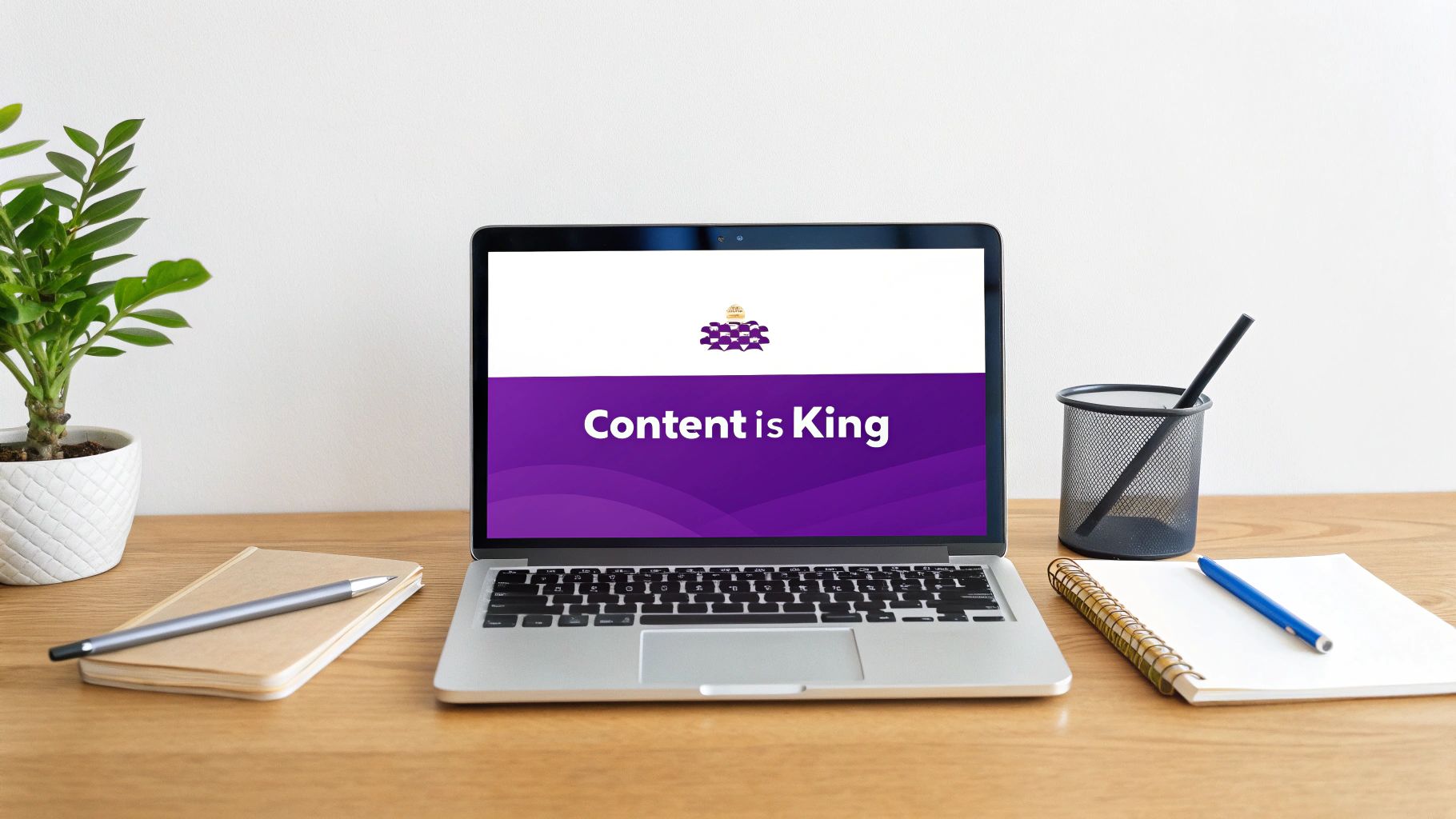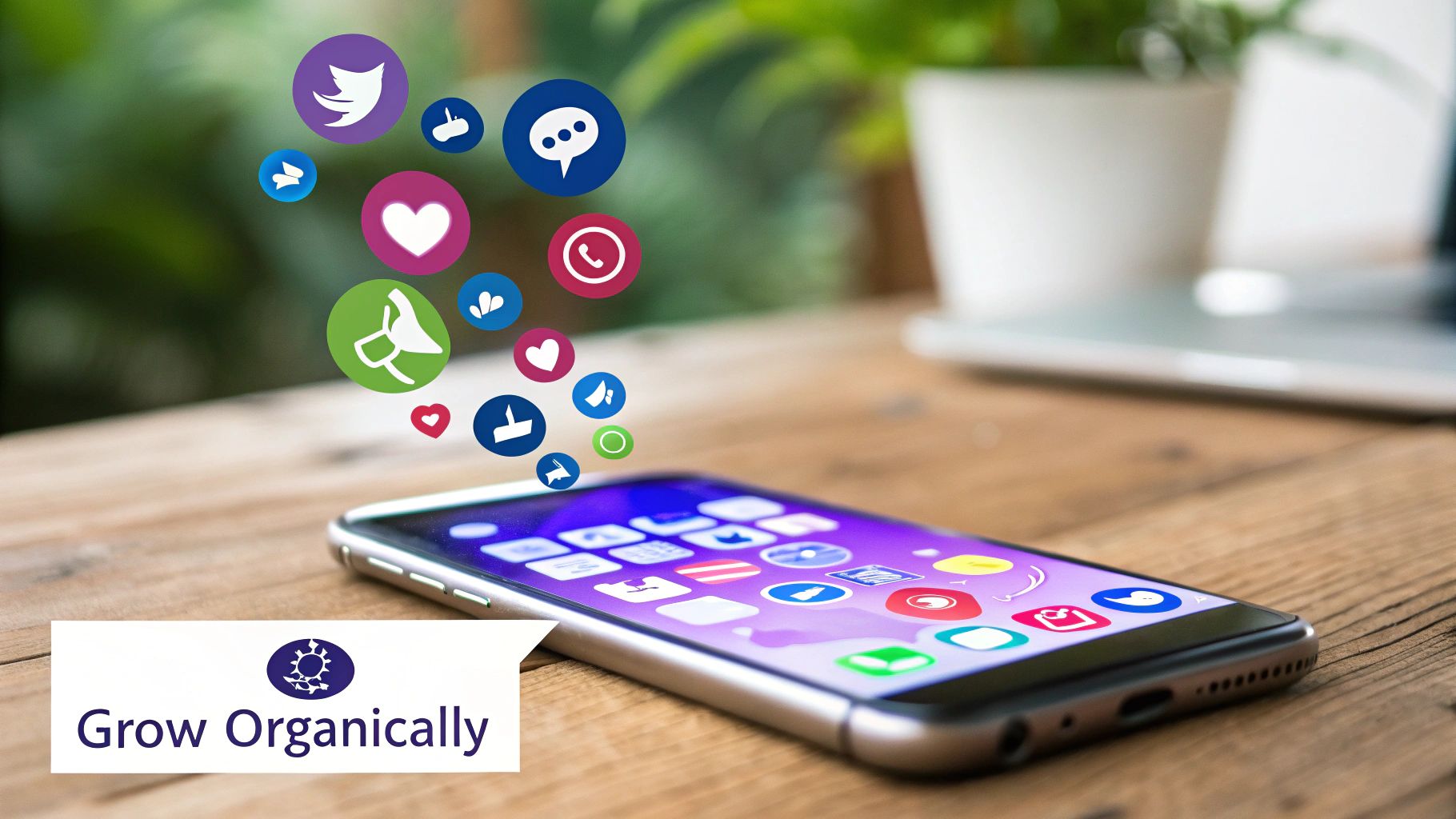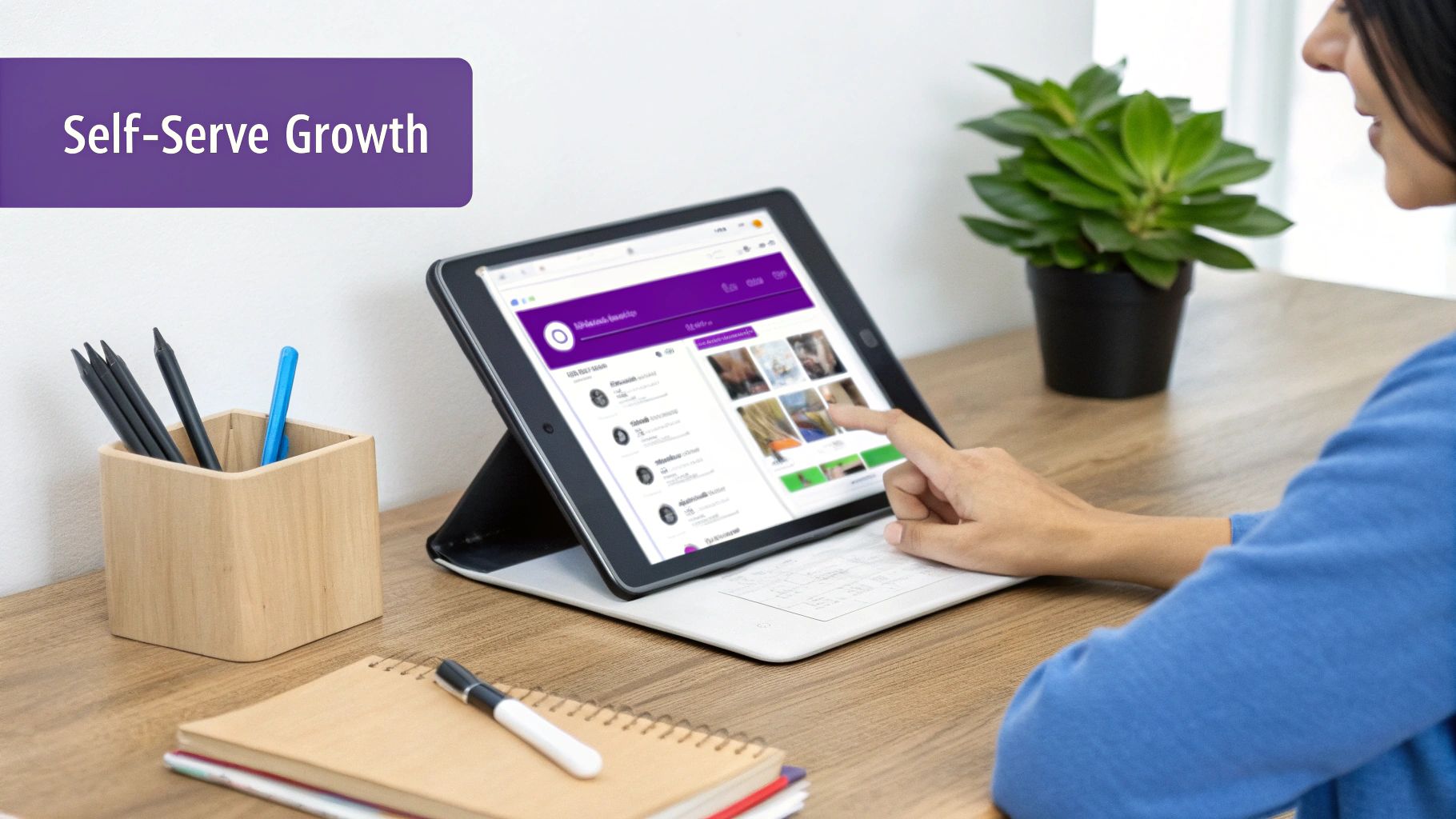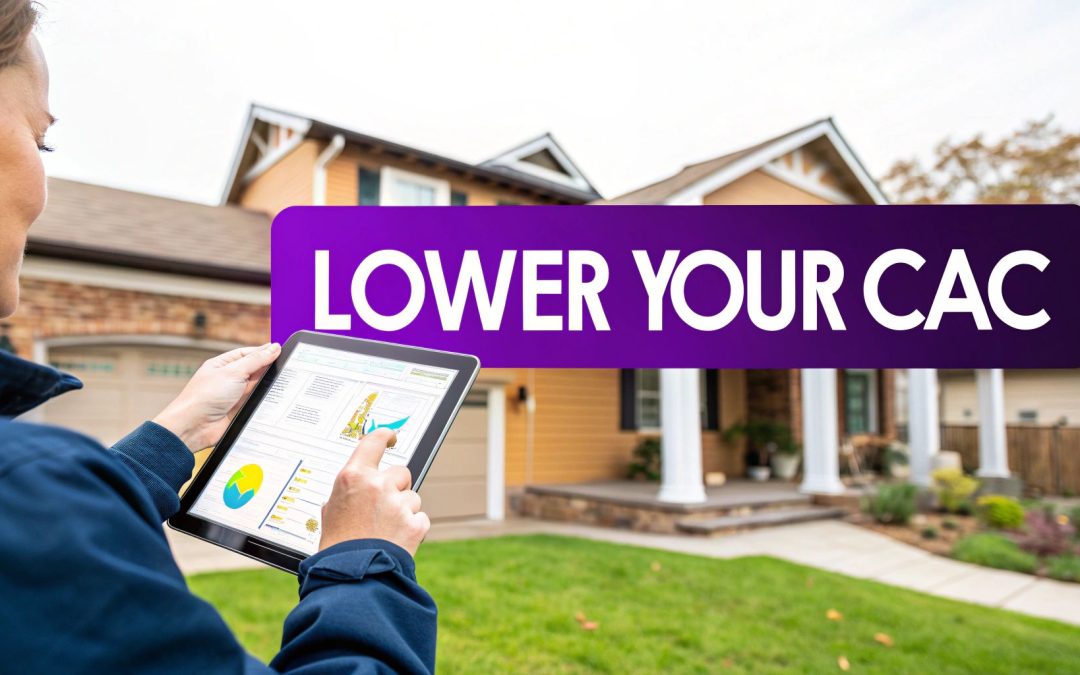Escaping the High-Cost Lead Trap: Your Guide to Smarter Growth
For home service businesses, the constant pressure to find new customers can feel like a costly, never-ending cycle. Paid ads, lead generation services, and aggressive marketing campaigns often eat directly into your profits, making sustainable growth seem out of reach. But what if there was a better way? What if you could attract more high-quality customers without constantly increasing your marketing budget? The key lies in strategically working to lower customer acquisition cost (CAC), which is the total expense of gaining a new customer.
This article moves past generic advice. It's a deep dive into seven proven, actionable strategies designed specifically to help your home service business thrive. We will explore how to build sustainable growth engines that work for you 24/7, turning your business into a magnet for ideal clients rather than just another buyer of expensive leads. From creating powerful referral programs to optimizing customer retention, each point is a practical blueprint for smarter, more profitable expansion.
By focusing on these methods, you can significantly reduce your reliance on high-cost advertising and build a more resilient business. Prepare to shift your perspective from simply acquiring customers to acquiring them profitably. Let's get started.
1. Build an Unstoppable Referral Engine
Referral marketing is one of the most effective strategies to lower customer acquisition cost because it leverages your most powerful asset: a satisfied customer. Instead of just hoping for word-of-mouth, building a structured referral engine transforms happy clients into an active, motivated sales force. For home service businesses like HVAC, plumbing, or landscaping, trust is paramount. A recommendation from a trusted friend or neighbor carries more weight than any paid advertisement, delivering high-intent leads at a fraction of the typical cost.

This approach works by systematizing the process of asking for and rewarding referrals. You are no longer passively waiting for leads; you are actively encouraging them. The core benefit is that you market through your existing customers, not just to new prospects. This significantly reduces spending on ads and lead generation services, directly impacting your CAC while bringing in customers who are already convinced of your value.
How to Implement a Referral Program
Creating a program that gets results requires more than just offering a generic discount. It needs to be simple, valuable, and easy to share.
- Define Clear, Two-Sided Incentives: A successful program rewards both the referrer (your current customer) and the new customer. For example, a roofing company could offer the existing customer a $250 gift card and give their referred friend a $250 discount on a full roof replacement. This two-way value proposition makes the referrer feel generous, not just self-serving.
- Automate the "Ask": Don’t leave the request for a referral to chance. Integrate the "ask" into your post-service follow-up. After a job is complete, send an automated email or text that confirms their satisfaction and then seamlessly introduces the referral program. Include a unique, shareable link or code that makes it easy for them to pass along.
- Equip Your Technicians: Your field team is your front line. Train them to identify happy customers and mention the referral program at the end of a successful service call. A simple line like, "We're so glad you're happy with the work. We have a great referral program if you know any neighbors who could use our help," can be incredibly effective. Provide them with physical cards or QR codes to hand out.
2. Content Marketing and SEO
Content marketing and SEO offer a powerful, long-term strategy to lower customer acquisition cost by turning your website into a magnet for qualified leads. Instead of paying for every click, you create valuable content that answers your potential customers' most pressing questions. For a home service business, this could be a blog post about "how to know if your water heater is failing" or a guide to "choosing the right HVAC system for your climate." When homeowners search for these topics, your business appears as a helpful authority, building trust before they even pick up the phone.

This approach, popularized by thought leaders like Marcus Sheridan with his "They Ask, You Answer" philosophy, fundamentally shifts your marketing from interruption to attraction. By consistently publishing useful information, you build a library of assets that generate organic traffic and leads around the clock. Over time, this drastically reduces your dependence on expensive paid ads, as your initial investment in content continues to pay dividends for months and even years. The result is a sustainable lead-generation engine that brings in high-intent customers who already see you as a trusted expert.
How to Implement Content Marketing and SEO
Effective content marketing requires a strategic focus on solving real customer problems, not just promoting your services. It's about becoming the go-to resource in your local market.
- Focus on Local, Problem-Solving Content: Brainstorm a list of questions your customers frequently ask. Create detailed blog posts, FAQs, and guides answering them. For example, a plumber in Phoenix could write an article titled, "5 Signs of Hard Water Damage to Your Pipes in Arizona Homes." This targets a specific local problem and attracts highly relevant search traffic.
- Build Topic Clusters and Pillar Pages: Organize your content strategically. Create a comprehensive "pillar page" on a broad topic like "Complete Guide to Air Conditioner Maintenance." Then, create shorter "cluster" blog posts on related sub-topics (e.g., "How to Clean AC Coils," "When to Replace Your Air Filter") that all link back to the main pillar page. This structure signals your expertise to Google and helps you rank for more keywords.
- Optimize for Local Search (Local SEO): Ensure your business name, address, and phone number are consistent everywhere online. Claim and fully optimize your Google Business Profile with photos, services, and posts. Encourage satisfied customers to leave reviews, as this is a major ranking factor for local service searches like "plumbers near me." If managing these tasks feels overwhelming, you can explore hiring specialized help. To get started, you can learn more about how to hire a virtual assistant for internet marketing.
3. Nurture Authentic Organic Social Media Growth
Organic social media growth is a powerful, long-term strategy to lower customer acquisition cost by building a genuine community around your brand. Instead of paying for every impression and click, you earn attention by providing consistent value, engaging in real conversations, and showcasing your company's human side. For home service businesses, platforms like Facebook and Instagram offer a direct line to local homeowners, allowing you to build trust and top-of-mind awareness before they even need your services.

This approach focuses on creating an asset-a loyal following-rather than just running a temporary campaign. By sharing helpful tips, before-and-after photos, and behind-the-scenes content, you establish your expertise and build rapport. When a follower's air conditioner breaks or their faucet starts leaking, your company is the one they remember and trust. This method generates high-quality inbound leads at a near-zero direct cost, making it a cornerstone of sustainable business growth.
How to Implement Organic Social Media Growth
Building an engaged following requires consistency and a genuine desire to connect, not just sell. The goal is to become a valuable part of your audience's daily feed.
- Create Shareable, Value-Driven Content: Don't just post about your promotions. Share content that helps your audience. A plumber could post a video on how to prevent frozen pipes in winter, or a landscaper could share a seasonal planting guide. This positions you as the go-to expert and encourages shares, extending your reach for free.
- Showcase Authenticity with Behind-the-Scenes Content: People connect with people. Share photos of your team on the job (with customer permission), celebrate employee milestones, or post a "day in the life" story of a technician. This humanizes your brand, making you more relatable and trustworthy than a faceless corporation.
- Engage Actively and Authentically: Social media is a two-way street. When someone comments on your post, reply thoughtfully. Answer questions publicly so others can benefit. Actively participate in local community groups (where permitted) by offering helpful advice, not just spamming your links. This proactive engagement builds a reputation for being helpful and present. Many businesses are even hiring virtual assistants for their social media management to ensure consistent and timely engagement.
4. Email Marketing Automation
Email marketing automation is a powerful tool to lower customer acquisition cost by systematically nurturing leads you've already generated. Instead of letting website visitors who requested a quote or downloaded a guide go cold, you can use automated email sequences to guide them toward a booking. For home service businesses, where a customer might need time to research options for a big project like a kitchen remodel or an AC installation, this strategy keeps your brand top-of-mind and builds trust over time, converting existing leads at a much lower cost than acquiring new ones.

This approach works by delivering the right message to the right person at the right time, all without manual effort. A prospect who downloaded a "Winterization Checklist" from your plumbing website is clearly interested in preventing frozen pipes. Automation allows you to follow up with a series of helpful tips and, eventually, an offer for a winterization inspection service. You are maximizing the value of every lead, reducing the need to constantly spend on new advertising to fill your schedule.
How to Implement Email Marketing Automation
Effective automation feels personal and helpful, not robotic. It's about building a relationship at scale by providing consistent value.
- Segment Your Email List: Don't send the same email to everyone. Divide your audience into segments based on their needs and history with your company. For example, a landscaping business could have separate lists for "New Leads (Lawn Care Interest)," "Past Mowing Clients," and "Past Hardscaping Project Clients." This allows for highly targeted messaging that resonates with each group.
- Create Trigger-Based Nurture Sequences: Set up automated workflows that begin when a user takes a specific action. If someone fills out your "Request an Estimate" form for window replacement, trigger a sequence that thanks them, explains the next steps, shares testimonials from other window clients, and sends a reminder if they haven't booked a consultation after a few days.
- Provide Value, Not Just Sales Pitches: Your emails should be genuinely useful. An electrician could send a seasonal sequence with tips on "How to Save on Your Electric Bill in the Summer" or "Holiday Lighting Safety." By establishing your expertise and helpfulness, you build trust, making it much more likely they will call you when they need professional service. The sale becomes the natural conclusion to the value you've already provided.
5. Partnership and Affiliate Marketing
Partnering with complementary, non-competing businesses is a strategic way to lower customer acquisition cost by tapping into an established and trusted audience. Instead of spending heavily to find new customers from scratch, you leverage the credibility and customer base of another local business. For a home service company, this means finding partners whose customers are also your ideal clients, creating a mutually beneficial stream of high-quality, low-cost leads.
This strategy works because it’s built on shared value and trust. When a real estate agent recommends your painting company to a new homebuyer, or an interior designer suggests your electrical services for a remodel, that lead comes with built-in authority. The cost is often a pre-agreed commission or reciprocal referral, which is significantly more efficient than broad-based advertising. You are acquiring customers through a warm introduction, not a cold pitch.
How to Implement a Partnership Program
Building a successful partnership network requires identifying the right allies and creating a structure that makes it easy and rewarding for them to send business your way.
- Identify Strategic Local Partners: Think about who serves homeowners right before, during, or after they need your services. An HVAC company could partner with roofing contractors, home inspectors, and property managers. A landscaping business could collaborate with pool installation companies and real estate agents specializing in high-end homes. The key is a shared target demographic without direct competition.
- Create a Simple, Valuable Offer: Your proposal to potential partners must be clear and compelling. Offer a straightforward commission structure, such as a flat fee per closed job or a percentage of the project total. For instance, an electrician could offer a local general contractor a 10% commission on any referred projects over $1,000. This performance-based payout ensures you only pay for actual business, keeping CAC low.
- Equip Partners for Success: Don’t just make a deal and hope for leads. Provide your partners with co-branded marketing materials like flyers, business cards, or a dedicated page on your website. Hold brief training sessions to help them understand your ideal customer and key services, so they can make more effective recommendations. A smooth process for managing these relationships, perhaps with the help of a virtual assistant, can make all the difference. Learn more about how hiring virtual assistants on phonestaffer.com can streamline these administrative tasks.
6. Maximize Customer Retention and Lifetime Value
Focusing on retention is one of the most powerful and often overlooked ways to lower customer acquisition cost. Instead of pouring all your resources into a leaky bucket of one-time customers, this strategy focuses on keeping your existing clients happy and engaged for the long term. For home service businesses, where trust is built over time, a loyal customer who calls you for every plumbing issue, HVAC tune-up, or electrical repair is immensely more profitable than constantly chasing new, unproven leads.
The logic is simple: it costs significantly less to get a repeat purchase from a satisfied customer than it does to acquire a new one. By increasing customer lifetime value (LTV), you generate more revenue per customer, which effectively reduces the net cost of acquiring them in the first place. This shifts your business model from a transactional one to a relational one, creating a stable, predictable revenue stream that isn't dependent on a constant, expensive marketing push.
How to Implement a Retention-Focused Strategy
Building loyalty requires a proactive, systematic approach to the entire customer journey, from the first service call to ongoing maintenance.
- Develop a Service Membership Program: Create a "club" or membership that offers tangible value. For example, an HVAC company could offer a plan that includes two annual tune-ups, priority scheduling, and a 15% discount on all repairs for a low monthly fee. This guarantees recurring revenue and makes you the default choice for any future needs, effectively locking out competitors.
- Automate Post-Service Communication: Your relationship shouldn't end when the technician leaves. Use your CRM to set up automated email or text message sequences. Send a thank you note, a request for feedback, and then schedule service reminders for six or twelve months later. This keeps your brand top-of-mind and shows you care about the customer's long-term satisfaction.
- Leverage Data for Upselling and Cross-Selling: Train your technicians to identify opportunities based on what they see. If a plumber is fixing a leaky faucet and notices the water heater is over 10 years old, they should be equipped to discuss replacement options or preventative maintenance. This isn't about being pushy; it's about providing expert advice that adds value for the customer while increasing the ticket size.
7. Adopt Product-Led Growth (PLG) Principles
While Product-Led Growth (PLG) is often associated with software companies like Slack or Zoom, its core principles can be creatively adapted to lower customer acquisition cost for home service businesses. The strategy revolves around letting your service or a "productized" version of it act as the main driver for acquiring new customers. Instead of relying solely on a high-touch sales process, you give potential clients a direct taste of the value you provide, leading them to a larger purchase organically.
For a home service business, this means shifting from selling a service to letting the service sell itself. Think of it as a "try before you buy" model, where a small, low-risk interaction demonstrates your quality and professionalism, making the decision to hire you for a major project much easier. This approach builds trust upfront and filters for serious customers, reducing wasted time on unqualified leads and expensive marketing efforts that don't convert.
How to Implement Product-Led Growth in Home Services
Adapting PLG requires you to "productize" an element of your expertise into a low-cost, high-value introductory offer that naturally leads to more significant work.
- Create an Irresistible "Tripwire" Offer: Develop a small, fixed-price service that solves a common pain point and showcases your skills. For example, an electrician could offer a "$99 Smart Home Assessment," or a plumber might offer a "$79 Water Heater Tune-Up and Efficiency Check." This initial transaction isn't about profit; it's about getting your foot in the door and proving your value.
- Engineer the "Aha Moment" On-Site: The goal of the introductory service is to deliver a moment of realization where the customer thinks, "Wow, these guys are pros." Train technicians to not only perform the service flawlessly but also to educate the customer. During the water heater tune-up, the plumber could use a tablet to show the homeowner sediment buildup and explain how a full system flush could save them money on energy bills, creating a natural upsell opportunity.
- Build an Upgrade Path: The initial offer must seamlessly connect to your core services. The smart home assessment should conclude with a clear, itemized quote for installing recommended devices. A lawn care company's "First Mow Free" offer should be immediately followed by a simple sign-up process for a seasonal maintenance plan, complete with an exclusive discount for acting now.
7 Strategies for Lowering Customer Acquisition Cost Compared
| Strategy | Implementation Complexity 🔄 | Resource Requirements ⚡ | Expected Outcomes 📊 | Ideal Use Cases 💡 | Key Advantages ⭐ |
|---|---|---|---|---|---|
| Referral Marketing Programs | Moderate: Needs program setup & management | Moderate: Customer base & tracking tools | High: Cost-effective acquisition & compound growth | B2C with satisfied customers | High conversion via trust, scalable, loyalty |
| Content Marketing and SEO | High: Consistent content creation & SEO expertise | Moderate: Content production & SEO tools | Long-term: Increasing organic traffic and authority | Brands focusing on inbound, education | Evergreen traffic, strong brand authority |
| Social Media Organic Growth | Moderate to High: Requires constant engagement | Low: Mainly time-intensive effort | Variable: Brand awareness & viral potential | Brand & community building on social platforms | Free to start, authentic engagement, viral potential |
| Email Marketing Automation | Moderate: Setup of workflows & segmentation | Low to Moderate: Email tools and lists | High ROI: Targeted nurturing & conversions | Lead nurturing and retention | High ROI, scalable personalization, 24/7 operation |
| Partnership and Affiliate Marketing | Moderate: Partner onboarding & tracking setup | Low to Moderate: Partner support & commission | Performance-based: Paid per conversion | Expanding reach via partners or influencers | Pay-for-performance, access new audiences |
| Customer Retention & LTV Optimization | Moderate to High: Infrastructure & management | Moderate: Customer success & loyalty programs | Increased revenue and advocacy | Mature businesses focused on existing customers | Cost-effective, increases lifetime value |
| Product-Led Growth (PLG) | High: Requires strong product dev & analytics | High: Product development & optimization | Scalable: Organic acquisition & retention via product | SaaS/freemium products with self-service | Low acquisition cost, high engagement, scalable |
From Cost Center to Growth Engine: Your Next Steps
Navigating the landscape of customer acquisition can feel like an endless expense, a constant drain on your resources. However, the strategies outlined in this guide aren't just about saving money. They represent a fundamental shift in perspective: transforming your customer acquisition from a costly necessity into a powerful, self-sustaining growth engine for your home service business. The goal is to move away from constantly "renting" attention through expensive ads and start "owning" your audience through value-driven, relationship-focused tactics.
We've explored seven potent strategies, each capable of significantly impacting your bottom line. From the exponential power of a well-structured referral program to the long-term authority built by content marketing and local SEO, these aren't isolated tricks. They are interconnected gears in a larger machine. Your authentic social media presence builds the community that fuels referrals, while your automated email marketing nurtures leads generated from your SEO efforts and strategic partnerships.
Turning Insights into Action
The key takeaway is that achieving a lower customer acquisition cost is not about implementing every strategy at once. It's about strategic, incremental improvement. The most successful home service businesses don't just find new customers; they build systems that attract and retain them efficiently.
Your immediate next steps should be methodical:
- Audit and Identify: Review your current acquisition channels. Where are you spending the most money for the least return? Which of the seven strategies discussed addresses your biggest weakness or offers the most significant opportunity?
- Select and Focus: Choose just one or two strategies to implement first. If your repeat business is low, start with customer retention and LTV optimization. If you have a strong customer base but no referral system, that's your starting point.
- Measure and Master: Define what success looks like. Track your CAC, conversion rates, and customer LTV meticulously. Master the chosen strategy, optimize its performance, and only then should you layer in the next one. This creates a powerful flywheel effect, where each new strategy amplifies the results of the others.
This journey transforms your business from being reactive to proactive, building a moat of profitability and resilience that your competitors, still reliant on expensive, short-term tactics, simply cannot match. You stop chasing leads and start creating a brand that customers seek out, trust, and recommend. It's the difference between surviving and truly thriving in the competitive home services market.
Many of these strategies hinge on capturing and converting every lead effectively. If missed calls or slow response times are letting valuable, hard-earned leads slip through the cracks, consider a dedicated solution. Phone Staffer provides professionally trained, US-based virtual receptionists for home service businesses, ensuring every call is answered and every opportunity is captured, directly helping you lower customer acquisition cost by maximizing the return on your marketing efforts.

